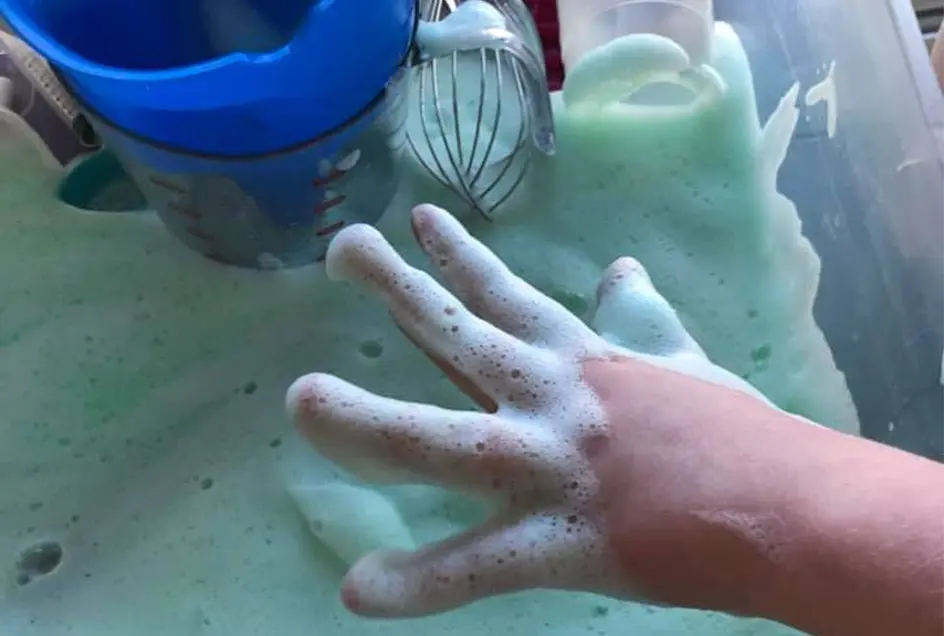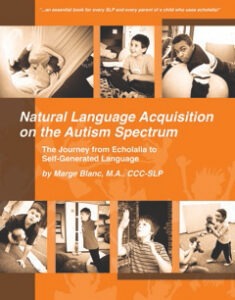Supports for Multi-Modal Communicators
Augmentative and alternative communication (AAC) displays and devices can be a life-line for individuals who are non-speaking, unreliably speaking, and/or developing language when aided language input is helpful. AAC is not one-size-fits-all, but before we explore the possibilities, let’s define AAC at a more general level.
AAC includes all modalities other than speech. AAC can ‘augment’ speech, or be an alternative to speech. Language and language development happen in our heads, and ways to express language are myriad, and each of them can be considered ‘augumentative or alternative’ communication and are no less legitimate than speech. Text-based communication, symbol-based systems, American Sign Language, other sign languages, gestures, drawing, accessing messages selected from other media such as movies and YouTube. All of these modalities can supplement speech, or be used instead of speech. They all qualify belong under the larger umbrella of AAC.
We typically think of AAC as symbol or word displays or dedicated devices, however ‘low tech’ core-word boards or other displays that can be used in places and activities, including board that are laminated and can go in a pool, or mounted on the wall, and even a giant one that we have seen used at a playground!
The article here introduces the notion of the umbrella term AAC — and then this post will continue with a section on ‘high tech’ AAC, including apps and dedicated devices to address the ‘complex needs’ of many communicators.
Robust AAC
The use of a robust device requires some motor skill and motor planning, and trials of various devices are often needed in order to find the right device for a particular communicator.
But the most important requirement for the success of any AAC is a communication partner who is dedicated also — dedicated to using the device themselves, in everyday situations with the child! This is the model we need for the AAC communicator, to show that it truly is valued as real communication!
Robust devices often have the capability of ‘voice output,’ which can be one of several digital voices, or, with many devices, recorded voice. Sometimes the ‘buy-in’ for a child is the use of a voice that resonates with them, for example a family member‘s voice. Or the voice of a favorite media character.
AAC and GLP
Here’s the caveat about AAC devices, however. They are set up for analytic language processors (ALPs), meaning they are devised for single word access, and word + word phrase-building. And they often fail to resonate with gestalt language processors at Stages 1 and 2. So to ensure that a GLP will find a device useful, gestalt language is added to a ‘robust’ single word system so that GLPs can communicate at Stages 1 and 2, but also so that single words will be available when they progress to Stage 3. The webinar linked here was put together by two SLPs, one an expert in gestalt language processing, the other an expert in AAC assessment.
Recommendations from that webinar include:
- Add gestalts from the child’s environment that the child will find appreciate and find important
- Try some new gestalts if they seem to resonate with the child
- Include video clips if they are the most resonant for a child
- Include audio clips when they are resonant
- Record your own voice if this makes the device work for your child
- Invent your own AAC. Maybe a ‘visual scene display’ will resonate most with your child. Use scenes from the child’s life, and add key phrases around the perimeter.
- Use the device creatively, as it can add language input to support a child’s language development, e.g. moving from Stage 1 to Stage 2, and Stage 2 to Stage 3.
We hope you enjoy the AAC and GLP webinar and handout! Please consider joining the AAC + GLP Group on Facebook for lots for information.
AAC: Intro, Part 1
AAC: Intro, Part2
If you suspect that AAC might be useful for your early-stage gestalt language processor, how can you begin?
The beginning steps are probes, playful steps into assessment! Paulina shows us how this might be done.

N of 1
AAC Supports for GLPs, Part 1
Can just-the-right AAC offer just-the-right support for your particular student? Maybe. Let’s think it through.
In the previous video, you saw how “Mom to N of 1“ figured it out for her son. AAC never resonated for him. ’N’ spent years trying to do what he was told to do by ‘experts.’ But it was the wrong ‘it.’ In the process, ’N’ gave up language.
Then…something ‘just right’ happened. His mom, his home-school mom, found the key. ’N’ loved Visual Scene Displays that pictured his own life, and loved his own language gestalts his mom included, and others that she trialed to go along with those scenes. ’N’ did not like the computer-generated voice, so his mom used only her own voice. This became part of the support that helped ’N’ move to Stage 2, then Stage 3, and more recently to the beginnings of Stage 4!
Now let’s turn to a very different scenario:
It’s a common one we hear: about some of our little ones, our often-silent, unintelligible two and three year olds — the kids who love their songs and YouTube clips, and love to listen again, and again, and again. An astute mom we know shared this common scenario: When she asks her three-and-a-half year old to come to the door to go to the park, he doesn’t respond. But when she communicates that message through his AAC, he runs to the door.
Added language input? Yes, of the very best kind! Why did it work? Well, we have a hypothesis. As another home-school parent, his mom had provided nearly unlimited AAC access + nearly unlimited music + almost-unlimited activity + adventure that resonated with her son for a long time, and she monitored the results.
In this conversation, Ereeni and Marge speculate on some factors that may be at play:
The auditory input of ’Go to the park’ was the same every time her boy hears it. It was like the instant rewind so many GLPs love (to learn from).
- The visual input remains the same too. Is it a ’scene’ like ‘N’ loves? No, but ‘A’ is a pattern boy…and we wonder if the patterns on his home screen are like ‘episodic events’ to him.
- The auditory + visual combo is a real-time combo. Unlike the parent at the door + a delayed acoustic signal — followed by the parent moving slightlys, followed by another acoustic signal that isn’t quite the same … real life is like that…there are no exact replays.
- This child has been watching and listening to his ‘talker’ — again and again and again — in his own time, and in his own way, without pressure. Another parent who provided similar Aided language input for her daughter told us that this kind of freedom eliminates any anxiety that come with real time expectations.
- Repeated auditory + visual might just create a template to support speaking those words as well, and there are already hints from both families that internal sources of sound (speech) now has something to match to.
Is this always a good idea? Of course not…the freedom given this boy was ’nearly unlimited,’ but it was monitored. Like the mom of “N,” the mom of “A” paid close attention, and kept impeccable notes on everything. She witnessed symbolic understanding emerging, referential language emerging, cross-modality learning, and even stuckedness in motor loops happening. As we all know, always, there is no one size fits all. But when we have the opportunity to teach, share, and monitor our own ’N of 1,’ we become the pioneers that our future qualitative research depends on!
Take a listen to our discussion and let us know your story. Look at the Discussion page under Info and send us an email! Thank you.
AAC Stage 1
7-24-2023
Comments
- AdminTop contributor“I’m sure you realize this is a very impossible post to comment on intelligently. But, given that your honest request is really where all of us are at the beginning, I thought it would be good to just share your open-ended question, and ask our resident experts to start the conversation.” Ereeni Roulakis and (Name not included)
- Top contributor“Hi Anonymous member, it really depends. I have given single word AAC to some GLP clients with very little customizing, and its worked out pretty well- a couple times it gave them a lifeline enough to start using mouth words so that I was able to find out their gestalts. Other times, I’ve started with something like PODD that is organized by communication and that has been a great place to start. Other times, I’ve created special folders for movie quotes and gestalts and it’s made my clients so much more interested in their device. That’s probably the most general advice- make a folder and put their gestalts in it and maybe some language model/possibilities that you think they might acquire as a gestalt. Sorry Marge to be so general!It really all depends, so much on the individual, how much access they have to mouth words, where they are in the stages of NLA, etc. Take a look at these two parents’ different set ups for ideas:YOUTUBE.COMSpeak for Yourself set-up for Stage 1/2 Gestalt Processing AAC user (take 2)
Speak for Yourself set-up for Stage 1/2 Gestalt Processing AAC user (take 2)
- (Name not included)“What software? What hardware? What GLP stage are they in? What is some of their language background? Definitely need more information to be able to assist. However, would love to provide you some feedback if given more information.”
- (Name not included)Top contributor“Which program? What age and stage?”
- (Name not included)Top contributor“There is an AAC group as well, probably better help.”
- (Name not included)“Listen to part 1 and 2 especially https://podcasts.apple.com/…/talking…/id1300126888…PODCASTS.APPLE.COMTalking With Tech AAC Podcast: Marge Blanc & Alexandria Zachos (Part 1): Supporting Students with Echolalia Using the Natural Language Acquisition Framework on Apple Podcasts
- (Name not included)“Ask Me, I’m an AAC user! (24 Hour Rule!) is a great resource too.”
